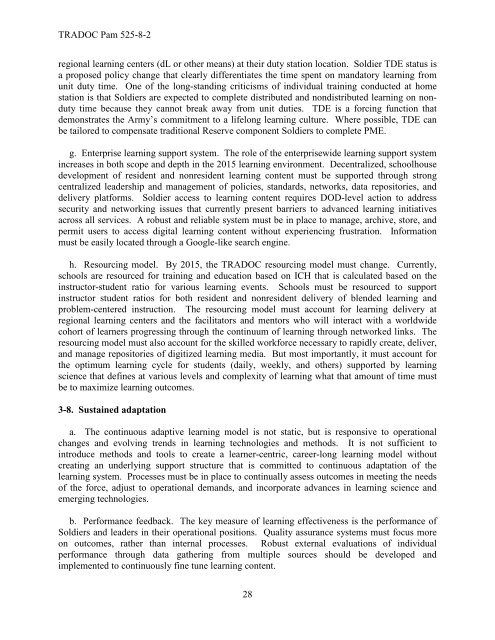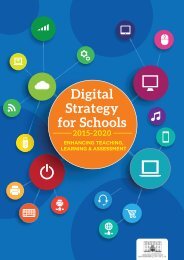K3zgZ
K3zgZ
K3zgZ
Create successful ePaper yourself
Turn your PDF publications into a flip-book with our unique Google optimized e-Paper software.
TRADOC Pam 525-8-2<br />
regional learning centers (dL or other means) at their duty station location. Soldier TDE status is<br />
a proposed policy change that clearly differentiates the time spent on mandatory learning from<br />
unit duty time. One of the long-standing criticisms of individual training conducted at home<br />
station is that Soldiers are expected to complete distributed and nondistributed learning on nonduty<br />
time because they cannot break away from unit duties. TDE is a forcing function that<br />
demonstrates the Army’s commitment to a lifelong learning culture. Where possible, TDE can<br />
be tailored to compensate traditional Reserve component Soldiers to complete PME.<br />
g. Enterprise learning support system. The role of the enterprisewide learning support system<br />
increases in both scope and depth in the 2015 learning environment. Decentralized, schoolhouse<br />
development of resident and nonresident learning content must be supported through strong<br />
centralized leadership and management of policies, standards, networks, data repositories, and<br />
delivery platforms. Soldier access to learning content requires DOD-level action to address<br />
security and networking issues that currently present barriers to advanced learning initiatives<br />
across all services. A robust and reliable system must be in place to manage, archive, store, and<br />
permit users to access digital learning content without experiencing frustration. Information<br />
must be easily located through a Google-like search engine.<br />
h. Resourcing model. By 2015, the TRADOC resourcing model must change. Currently,<br />
schools are resourced for training and education based on ICH that is calculated based on the<br />
instructor-student ratio for various learning events. Schools must be resourced to support<br />
instructor student ratios for both resident and nonresident delivery of blended learning and<br />
problem-centered instruction. The resourcing model must account for learning delivery at<br />
regional learning centers and the facilitators and mentors who will interact with a worldwide<br />
cohort of learners progressing through the continuum of learning through networked links. The<br />
resourcing model must also account for the skilled workforce necessary to rapidly create, deliver,<br />
and manage repositories of digitized learning media. But most importantly, it must account for<br />
the optimum learning cycle for students (daily, weekly, and others) supported by learning<br />
science that defines at various levels and complexity of learning what that amount of time must<br />
be to maximize learning outcomes.<br />
3-8. Sustained adaptation<br />
a. The continuous adaptive learning model is not static, but is responsive to operational<br />
changes and evolving trends in learning technologies and methods. It is not sufficient to<br />
introduce methods and tools to create a learner-centric, career-long learning model without<br />
creating an underlying support structure that is committed to continuous adaptation of the<br />
learning system. Processes must be in place to continually assess outcomes in meeting the needs<br />
of the force, adjust to operational demands, and incorporate advances in learning science and<br />
emerging technologies.<br />
b. Performance feedback. The key measure of learning effectiveness is the performance of<br />
Soldiers and leaders in their operational positions. Quality assurance systems must focus more<br />
on outcomes, rather than internal processes. Robust external evaluations of individual<br />
performance through data gathering from multiple sources should be developed and<br />
implemented to continuously fine tune learning content.<br />
28




